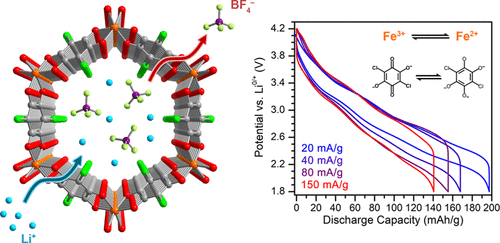当前位置:
X-MOL 学术
›
J. Am. Chem. Soc.
›
论文详情
Our official English website, www.x-mol.net, welcomes your feedback! (Note: you will need to create a separate account there.)
Effects of Covalency on Anionic Redox Chemistry in Semiquinoid-Based Metal–Organic Frameworks
Journal of the American Chemical Society ( IF 15.0 ) Pub Date : 2020-01-15 , DOI: 10.1021/jacs.9b13050 Michael E Ziebel 1, 2 , Carlo Alberto Gaggioli 3 , Ari B Turkiewicz 1 , Won Ryu 4 , Laura Gagliardi 3 , Jeffrey R Long 1, 2, 4
Journal of the American Chemical Society ( IF 15.0 ) Pub Date : 2020-01-15 , DOI: 10.1021/jacs.9b13050 Michael E Ziebel 1, 2 , Carlo Alberto Gaggioli 3 , Ari B Turkiewicz 1 , Won Ryu 4 , Laura Gagliardi 3 , Jeffrey R Long 1, 2, 4
Affiliation

|
Two iron-semiquinoid framework materials, (H2NMe2)2Fe2(Cl2dhbq)3 (1) and (H2NMe2)4Fe3(Cl2dhbq)3(SO4)2 (Cl2dhbqn- = deprotonated 2,5-dichloro-3,6-dihydroxybenzoquinone) (2-SO4), are shown to possess electrochemical capacities of up to 195 mAh/g. Employing a variety of spectroscopic methods, we demonstrate that these exceptional capacities arise from a combination of metal- and ligand-centered redox processes, a result supported by electronic structure calculations. Importantly, similar capacities are not observed in isostructural frameworks containing redox-inactive metal ions, highlighting the importance of energy alignment between metal and ligand orbitals to achieve high capacities at high potentials in these materials. Prototype lithium-ion devices constructed using 1 as a cathode demonstrate reasonable capacity retention over 50 cycles, with a peak specific energy of 533 Wh/kg, representing the highest value yet reported for a metal-organic framework. In contrast, the capacities of devices using 2-SO4 as a cathode rapidly diminish over several cycles due to the low electronic conductivity of the material, illustrating the non-viability of insulating frameworks as cathode materials. Finally, 1 is further demonstrated to access similar capacities as a sodium-ion or potassium-ion cathode. Together, these results demonstrate the feasibility and versatility of metal-organic frameworks as energy storage materials for a wide range of battery chemistries.
中文翻译:

共价键对半醌基金属-有机骨架中阴离子氧化还原化学的影响
两种铁半醌骨架材料,(H2NMe2)2Fe2(Cl2dhbq)3 (1) 和 (H2NMe2)4Fe3(Cl2dhbq)3(SO4)2 (Cl2dhbqn- = 去质子化的 2,5-二氯-3,6-二羟基苯醌) (2 -SO4),具有高达 195 mAh/g 的电化学容量。采用各种光谱方法,我们证明了这些特殊的能力来自以金属和配体为中心的氧化还原过程的组合,这一结果得到了电子结构计算的支持。重要的是,在含有氧化还原惰性金属离子的同构骨架中没有观察到类似的容量,这突显了金属和配体轨道之间能量对齐的重要性,以在这些材料的高电位下实现高容量。使用 1 作为阴极构建的原型锂离子设备在 50 次循环中表现出合理的容量保持率,峰值比能量为 533 Wh/kg,代表金属有机骨架迄今报道的最高值。相比之下,由于材料的低电子电导率,使用 2-SO4 作为阴极的设备的容量在几个循环中迅速降低,这说明绝缘框架作为阴极材料的可行性。最后,进一步证明 1 具有与钠离子或钾离子阴极类似的容量。总之,这些结果证明了金属有机框架作为各种电池化学储能材料的可行性和多功能性。由于材料的低电子电导率,使用 2-SO4 作为阴极的器件的容量在几个循环中迅速降低,这说明绝缘框架作为阴极材料的可行性。最后,进一步证明 1 具有与钠离子或钾离子阴极类似的容量。总之,这些结果证明了金属有机框架作为各种电池化学储能材料的可行性和多功能性。由于材料的低电子电导率,使用 2-SO4 作为阴极的器件的容量在几个循环中迅速降低,这说明绝缘框架作为阴极材料的可行性。最后,进一步证明 1 具有与钠离子或钾离子阴极类似的容量。总之,这些结果证明了金属有机框架作为各种电池化学储能材料的可行性和多功能性。
更新日期:2020-01-15
中文翻译:

共价键对半醌基金属-有机骨架中阴离子氧化还原化学的影响
两种铁半醌骨架材料,(H2NMe2)2Fe2(Cl2dhbq)3 (1) 和 (H2NMe2)4Fe3(Cl2dhbq)3(SO4)2 (Cl2dhbqn- = 去质子化的 2,5-二氯-3,6-二羟基苯醌) (2 -SO4),具有高达 195 mAh/g 的电化学容量。采用各种光谱方法,我们证明了这些特殊的能力来自以金属和配体为中心的氧化还原过程的组合,这一结果得到了电子结构计算的支持。重要的是,在含有氧化还原惰性金属离子的同构骨架中没有观察到类似的容量,这突显了金属和配体轨道之间能量对齐的重要性,以在这些材料的高电位下实现高容量。使用 1 作为阴极构建的原型锂离子设备在 50 次循环中表现出合理的容量保持率,峰值比能量为 533 Wh/kg,代表金属有机骨架迄今报道的最高值。相比之下,由于材料的低电子电导率,使用 2-SO4 作为阴极的设备的容量在几个循环中迅速降低,这说明绝缘框架作为阴极材料的可行性。最后,进一步证明 1 具有与钠离子或钾离子阴极类似的容量。总之,这些结果证明了金属有机框架作为各种电池化学储能材料的可行性和多功能性。由于材料的低电子电导率,使用 2-SO4 作为阴极的器件的容量在几个循环中迅速降低,这说明绝缘框架作为阴极材料的可行性。最后,进一步证明 1 具有与钠离子或钾离子阴极类似的容量。总之,这些结果证明了金属有机框架作为各种电池化学储能材料的可行性和多功能性。由于材料的低电子电导率,使用 2-SO4 作为阴极的器件的容量在几个循环中迅速降低,这说明绝缘框架作为阴极材料的可行性。最后,进一步证明 1 具有与钠离子或钾离子阴极类似的容量。总之,这些结果证明了金属有机框架作为各种电池化学储能材料的可行性和多功能性。



























 京公网安备 11010802027423号
京公网安备 11010802027423号